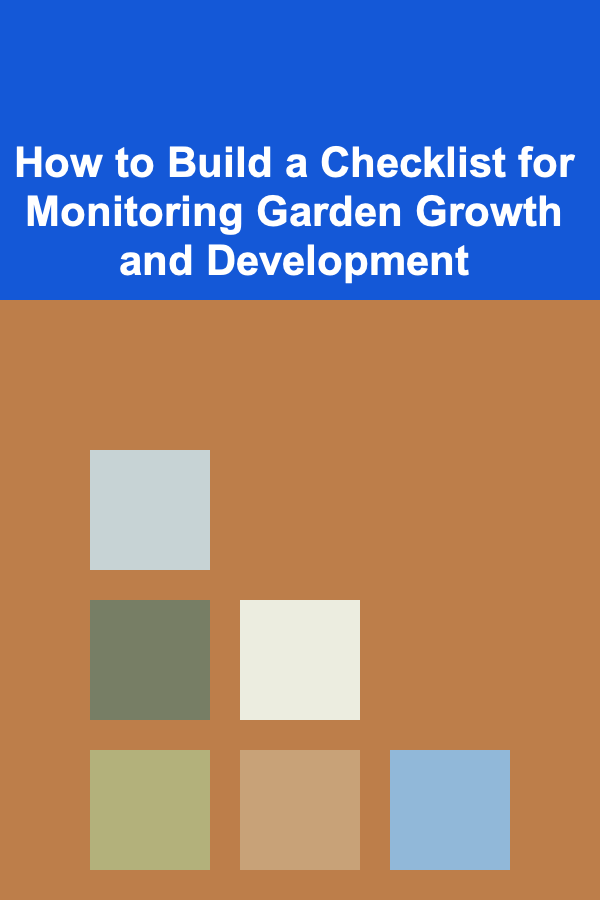
How to Build a Checklist for Monitoring Garden Growth and Development
ebook include PDF & Audio bundle (Micro Guide)
$12.99$11.99
Limited Time Offer! Order within the next:

Gardening is both an art and a science. While the joy of watching plants grow and thrive is a major part of the experience, keeping track of their progress is equally important. A structured approach can help gardeners understand what's working, what needs improvement, and when action is necessary. One of the best ways to achieve this is by creating a checklist to monitor garden growth and development.
An actionable checklist helps track various aspects of plant health, growth stages, and garden maintenance. This guide will walk you through how to build an effective and comprehensive checklist to help monitor your garden, whether you're a beginner or an experienced gardener.
Establish Your Garden Goals
Before diving into the specifics of monitoring, it's essential to define your goals for the garden. What do you want to achieve with your plants? Your goals will shape your checklist. Are you aiming for a vegetable garden with a high yield? Do you want to cultivate flowering plants for aesthetic purposes, or are you trying to grow native plants that are sustainable for your region?
Examples of Garden Goals:
- Increase vegetable yield by a certain percentage.
- Grow healthy plants without using chemical pesticides.
- Ensure the garden provides year-round blooms or harvests.
- Maintain soil health for long-term sustainability.
Once you have clear goals in mind, you can tailor your checklist to focus on the most critical aspects of plant development based on those objectives.
Understand the Key Stages of Plant Growth
Monitoring garden growth requires an understanding of the various growth stages plants go through. Plants typically follow a general progression, from seed germination to maturation. However, the timeline and specifics vary based on plant species, climate, and care practices.
Key Stages of Plant Growth:
- Germination: The stage where seeds begin to sprout and establish roots.
- Seedling Stage: After germination, the plant starts developing leaves and stems.
- Vegetative Growth: During this phase, the plant focuses on developing its roots, leaves, and stems.
- Flowering/Fruiting: Plants enter reproductive growth, where flowers bloom or fruits begin to form.
- Maturity and Harvest: The plant has fully developed, and it's time for harvesting (in edible plants) or general upkeep in ornamental gardens.
Having a clear understanding of these stages is essential for monitoring progress. Your checklist will be more effective when you know what to look for at each stage.
Key Aspects to Monitor in Your Garden
Now that you understand the growth stages, let's explore the main categories you need to track in your checklist. Each category focuses on different aspects of plant care, and monitoring them regularly will ensure the plants are on the right path to thriving.
A. Soil Health
Soil is the foundation of a garden, and its health directly impacts plant growth. Here are the key things to monitor related to soil:
- Soil Moisture: Keep track of when the soil needs watering. Over or under-watering can stress plants, so ensure the moisture levels are ideal for each plant type.
- Soil pH: Regularly test soil pH to ensure it's within the optimal range for your plants. Most plants prefer slightly acidic soil (pH 6.0--7.0), but some plants may have different requirements.
- Nutrient Levels: Monitor the nutrient content of your soil. If necessary, apply organic or chemical fertilizers to ensure plants are receiving enough nutrients, especially during critical growth phases.
B. Plant Health
Monitoring the health of your plants is vital for preventing problems before they become widespread. Here's what to track:
- Signs of Disease or Pests: Look for discolored leaves, spots, holes, or deformed plant parts. Early detection can prevent pest infestations and the spread of diseases.
- Growth Rate: Monitor the growth speed of your plants. If some plants are lagging behind others, it could indicate a problem with nutrition, light, or watering.
- Leaf Color and Texture: Healthy plants should have vibrant leaves. Yellowing, wilting, or crispy leaves could indicate issues such as overwatering, nutrient deficiencies, or pests.
C. Environmental Conditions
Environmental factors like temperature, sunlight, and humidity can all influence garden growth. Keep an eye on the following:
- Temperature Range: Ensure that the temperature is within the optimal range for your plants, especially if you live in a climate with extreme temperatures. Protect sensitive plants from frost or excessive heat.
- Light Levels: Track how much sunlight each section of your garden receives. Some plants need full sun, while others thrive in partial shade.
- Humidity and Rainfall: Monitor humidity levels, especially for tropical or humidity-sensitive plants. Track rainfall and adjust irrigation accordingly.
D. Growth Milestones
Document key milestones in plant growth to track their progress effectively. This can help with both monitoring and planning for future tasks. Common milestones include:
- Germination: When seeds sprout.
- First True Leaves: The appearance of the plant's first true leaves (not the seed leaves) indicates healthy development.
- Flowering: For flowering plants, mark when the first buds appear.
- Fruiting or Seed Production: For edibles, note when fruits or seeds begin to form.
E. Weed and Pest Control
Weeds and pests can quickly become a problem in a garden. Monitoring for these issues early can help prevent them from taking over:
- Weeds: Keep a record of areas where weeds are most prevalent and regularly remove them. Tracking weed growth helps determine which areas are more prone to competition with your plants.
- Pest Infestation: Regularly inspect plants for signs of insect activity (e.g., aphids, caterpillars) or other pests (e.g., slugs). Monitoring pest pressure helps decide when to apply treatments or employ natural predators.
Building the Checklist
Now that you have a clear understanding of what to monitor, it's time to build the checklist. A checklist helps ensure consistency and allows you to track changes over time. Consider using a spreadsheet, journal, or even an app to make the process easier.
Example Garden Growth Checklist Template:
Here's a sample checklist structure you can modify to suit your garden:
| Date | Task | Action/Observation | Notes | |------------|------------------------|-------------------------------------------|--------------------------------| | 04/20/2025 | Soil Moisture Check | Soil is dry; water needed for most plants | Add mulch to retain moisture | | 04/21/2025 | Pest Inspection | Found aphids on tomato plants | Use neem oil spray | | 04/22/2025 | Growth Milestone | Peppers have reached 6 inches in height | Time for staking | | 04/23/2025 | Temperature Check | Temperatures dropped to 40°F | Bring sensitive plants indoors | | 04/24/2025 | Fertilizer Application | Added compost around tomatoes | Organic fertilizer used | | 04/25/2025 | Weeding | Weeds in garden beds removed | Focus on root removal |
You can break down your checklist into specific tasks for daily, weekly, or monthly monitoring. The frequency of tasks will depend on your garden's needs and the plant species you are growing. Over time, you'll develop a rhythm for when certain tasks need to be performed.
Review and Adjust
As your garden progresses, it's important to review your checklist and adjust it accordingly. Weather conditions, plant health, and seasonal changes may all require modifications to your monitoring routine. Regular reviews of your checklist will help you stay on top of changes and ensure the best outcomes for your garden.
Conclusion
Building and maintaining a checklist for monitoring garden growth and development is an essential tool for any gardener. It allows you to stay organized, track plant health, and identify issues before they escalate. By focusing on soil health, plant condition, environmental factors, growth milestones, and pest management, your garden will be on track to thrive. Customize your checklist to fit your specific needs and remember that consistency is key. With a structured approach, you can ensure a flourishing, healthy garden year after year.

10 Easy and Affordable DIY Home Organization Ideas for Every Room
Read More
How to Create a Passive Income Business by Using Deep Learning
Read More
How to Soundproof Your Home Using Recycled Materials
Read More
How to Use Clear Containers for Closet Organization
Read More
How to Find Cheap Flights to Anywhere
Read More
How To Become a Personal Trainer
Read MoreOther Products

10 Easy and Affordable DIY Home Organization Ideas for Every Room
Read More
How to Create a Passive Income Business by Using Deep Learning
Read More
How to Soundproof Your Home Using Recycled Materials
Read More
How to Use Clear Containers for Closet Organization
Read More
How to Find Cheap Flights to Anywhere
Read More